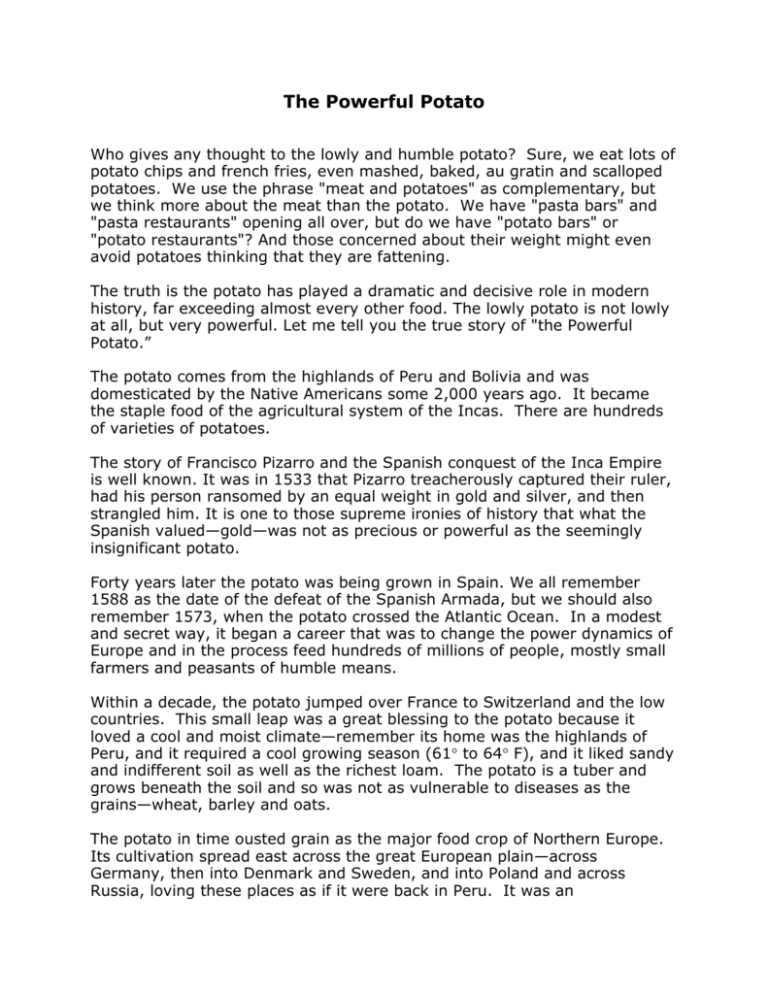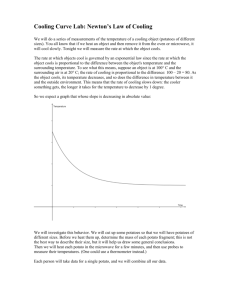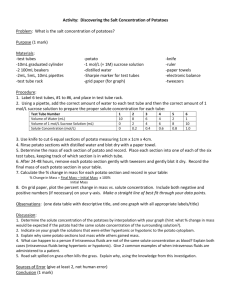The Powerful Potato
advertisement

The Powerful Potato Who gives any thought to the lowly and humble potato? Sure, we eat lots of potato chips and french fries, even mashed, baked, au gratin and scalloped potatoes. We use the phrase "meat and potatoes" as complementary, but we think more about the meat than the potato. We have "pasta bars" and "pasta restaurants" opening all over, but do we have "potato bars" or "potato restaurants"? And those concerned about their weight might even avoid potatoes thinking that they are fattening. The truth is the potato has played a dramatic and decisive role in modern history, far exceeding almost every other food. The lowly potato is not lowly at all, but very powerful. Let me tell you the true story of "the Powerful Potato.” The potato comes from the highlands of Peru and Bolivia and was domesticated by the Native Americans some 2,000 years ago. It became the staple food of the agricultural system of the Incas. There are hundreds of varieties of potatoes. The story of Francisco Pizarro and the Spanish conquest of the Inca Empire is well known. It was in 1533 that Pizarro treacherously captured their ruler, had his person ransomed by an equal weight in gold and silver, and then strangled him. It is one to those supreme ironies of history that what the Spanish valued—gold—was not as precious or powerful as the seemingly insignificant potato. Forty years later the potato was being grown in Spain. We all remember 1588 as the date of the defeat of the Spanish Armada, but we should also remember 1573, when the potato crossed the Atlantic Ocean. In a modest and secret way, it began a career that was to change the power dynamics of Europe and in the process feed hundreds of millions of people, mostly small farmers and peasants of humble means. Within a decade, the potato jumped over France to Switzerland and the low countries. This small leap was a great blessing to the potato because it loved a cool and moist climate—remember its home was the highlands of Peru, and it required a cool growing season (61 to 64 F), and it liked sandy and indifferent soil as well as the richest loam. The potato is a tuber and grows beneath the soil and so was not as vulnerable to diseases as the grains—wheat, barley and oats. The potato in time ousted grain as the major food crop of Northern Europe. Its cultivation spread east across the great European plain—across Germany, then into Denmark and Sweden, and into Poland and across Russia, loving these places as if it were back in Peru. It was an uncomplicated plant to cultivate, and in these countries, it was exceptionally reliable. As wonderful as these blessings were, they did not constitute the potato's greatest blessing. The inexpensive potato is almost the perfect food. It is the perfect food with milk. A diet of milk and potatoes supplies all the nutrients the human body needs. The potato is 85% starch (carbohydrates) and 15% protein. It has a considerable amount of vitamin C; it also has niacin, riboflavin, thiamin, calcium, iron, magnesium, phosphorus, potassium, and sodium. It is not fattening (unless soaked in butter, oil, or gravy), and a 6-8 ounce potato contains fewer than 100 calories. Because of the potato, the health of the lower classes of northern Europe improved significantly and life expectancy increased. So, in the period 1650 to 1800, the volume of potatoes grew astronomically. Acreage that could barely support a family could now support many families. In the early 1700's, the potato crossed the North Sea into England, Scotland, and Wales. It loved these countries just as well as the Netherlands and Germany. Then it jumped the Irish Sea and became so important in Ireland that it became known as the "Irish Potato." Immigrants brought the potato from Europe to North America in 1700, and by 1719, it was being grown in volume in New Hampshire. It made its home here and today we identify potatoes from Maine and Idaho. So, the potato had recrossed the Atlantic Ocean. In the 1500's, the most populated and economically powerful countries of Europe were in and around the Mediterranean–Spain, Italy, and France. Their population and economic power supported great armies. In the period 1700 to 1850, the populations of the countries of Northern Europe doubled, tripled, even quadrupled. By 1850, Russia was the most populated European country and Germany had half again as many people as France. Great Britain, a country of 2,000,000 in 1500, had become a nation of 25,000,000 in 1850, and from an agricultural country, it became the leading industrial power. —Larry Schaefer Lake Country Institute







